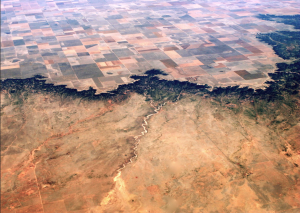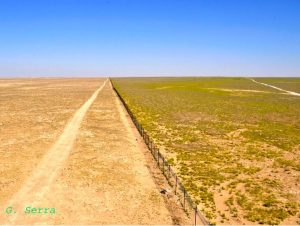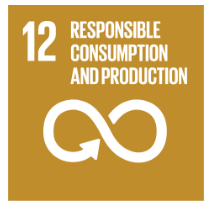Sarina Christen
The surface of the earth is about 510 Mio. km2 large and the major part (71%) is covered with water. The remaining part, about 149 Mio. km2, accordingly is land surface, which is the base for life on land. But humankind and its activities thread the health of the soil and damages it enduringly, so it cannot be used anymore. Land and soil are consequently a non-renewable resource, which should be treated more cautious and in a sustainable way.
Functions and services provided from a healthy soil
Soils do very different types of services at the same time but not in the same intensity. These services bring advantages for human, plants and animals. To evaluate the soil condition, you must consider all types of functions to get an informative image. The features of a soil determine its possible function and with that the possible service for humans. The functions of a soil can basically be categorised into four groups: regulation functions, habitat functions, economic functions and scientific functions. (Kretzschmar, 2017), (BAFU, 2017)
Regulation functions contain for example water and nutrient storage, filtration of pollutants and buffering flux of water and solutes. Rainwater will be transformed into ground water with drinking water qualities, after it passed healthy soil layers. The features of a soil determine its storage capacity of water and regulate thereby a landscapes water household. In addition to this, soil can be a source or sink for greenhouse gases especially CO2 and CH4. Soils and the vegetation growing above are important storages of these climate-relevant gases. Every change of use can affect an increase or decrease of this store capacity because it changes the deposition conditions of organic substance. Often, the change of use will cause increased exposition of these greenhouse gases. One prominent example is the drainage of bogs followed by peat mining. Thereby the bog loses its valuable features and a lot of CO2 will be released due to respiration of destruents and due to the burning of peat. (Kretzschmar, 2017), (BAFU, 2017)
Providing habitats to microorganisms, plants and animals is the base of terrestrial ecosystems and it is perhaps a rather obvious service but very important at least for humans. The biodiversity in soil is gigantic. In only 1g soil there can be up to 109 bacteria and up to 106 individuals of protozoa. Plants can anchor and resorb rainwater and nutrients with their roots from the soil. With sunlight and CO2 from the atmosphere, the plant can build up biomass via photosynthesis. This biomass provides food to human and animals. Dead organic matter, mainly from plants, constitutes food to destruents, such as soil animals and microbes. Via their respiration, CO2 is formed, and bonded nutrients are mineralised and again available for living plants. (Kretzschmar, 2017), (BAFU, 2017)
Soil with its layers can save information from the past. It is like an archive of formation history. It constitutes a source for archaeologist, which search objects from history of civilization. But it is not only interesting for archaeologists but also for palaeontologists which search objects from history of nature. Allied with this part of science is paleoclimatology which is the research of climate in Earth’s history. Paleoclimatologists also can find their data for research, saved in the layers of a soil. (Kretzschmar, 2017), (BAFU, 2017)
Soils are important for production of variety of materials such as building material (sand, gravel, clay) or combustible material (peat). They are also important for agriculture and forestry, more precisely for human nutrition and wood production. Soils providing settlement area i.e. land for buildings and infrastructure such as streets and landfills. Today the biggest amount of land is used by agriculture, by forestry or as cultivated land. A less quantifiable function is providing recreation area, with the nature growing on it. Such areas to spend your free time are very important for personal health. (Kretzschmar, 2017)
There is a competition in usage within the different functions of use. Some functions can be provided at the same time, for example forestry and recreation area. Other exclude one another, such as agriculture and settlement area. It must be planned in a long-term, where land is used for which function, because some usages are irreversible (for example industrial site cannot easily be changed into agricultural area). That may be problematic in densely populated areas. (Kretzschmar, 2017)
Threat to functions of soil
The health of soil is threatened by a variety of processes driven by humans. Destruction of soil fertility is one of the top environmental problems in many regions, because the fertile layer formed itself in thousands of years. If its impaired, it will take again thousands of years to recover itself. Soil, that has been treated in an incautious way, may has lost its ability to fulfil functions that are important for humans. In this paragraph, you can find the most important impairment of soil from small-scale to large-scale and the role of human in it, excluding the impairments by pollutant input. (Kretzschmar, 2017), (BAFU, 2017)
Sealing means covering soil with impermeable layers like tar, concrete or whole buildings. Today 60% of the settlement area and 4-5% of the total of Switzerland are sealed. The problem is, that this cover stops the exchange of gas and the infiltration of water. If the cover is complete, the underlying soil will lose its functions for example the habitat function and regulation function. In canalized areas such as settlements, rainwater will flow surficial into the canalisation, and in heavy rains, flood risk will increase. (Kretzschmar, 2017), (BAFU, 2017), (BFS, -)
Compaction of soils is another risk to soil health, because it reduces the important porosity and with that, the infiltration of water and the exchange of gases. This can cause an increased erosion rate, a worse root penetration and followed by that, the soil can be used less productively for agriculture. Soil compaction happens, when farmers do machine work with too heavy machines on too moist soils. Compaction in the solum can be scattered again, but this works not for compaction in the subsoil. (Kretzschmar, 2017)
Erosion is one of most threatening processes at a larger scale. It is defined as lateral removal of soil material at soil surface by wind or water. So, there are two types of erosion: water erosion and wind erosion. Factors that affect the erosion rate are relief position, distribution of precipitation, soil coverage with vegetation and water infiltration rate. (Kretzschmar, 2017)
Water erosion occurs, when the porosity of a soil is poor, for example after soil compaction. Then water cannot seep into the soil and will flow surficial. With this flow, it will entrain other soil particles and deposit in a sink region and causes silting up. Water erosion can also cause an incrustation in the source area, followed by a worse aeration and a worse workability. In addition to this, water in the source region cannot infiltrate and will be missed. In the sink region more water comes from overflow and probably will flood the land. But not only water and particles will be transported, but also saluted nutrients. This can cause an eutrophication in the sink area and a loss of nutrients in the source area. (Kretzschmar, 2017)

Figure 60.1 – Figure ii: Water erosion in Grady, New Mexico, USA
Wind erosion takes place, when wind blows with 4-5m/s close over a surface, because then it can liberate particles, which then may be transported over long distances to another place. A common phenomenon here in Switzerland is, when sand from the Sahara Desert is transported to the atmosphere over Middle Europe. A process called saltation, where particles with their bounce on the soil liberate other particles, intensifies wind erosion. (Kretzschmar, 2017)

Figure 60.2 – Figure iii: Desertification in Syria.
Left side of the fence: uncontrolled sheep grazing was allowed.
Right side of the fence: experimental sheep grazing exclusion zone
Desertification is the expansion of deserts under human influence. One example is desertification in the Sahel Zone. Due to population growth, pressure of usage has increased and because of that, grassland have been overgrazed and forest have been deforested to gain farmland and settlement area. A consequence is, that there is less field migration and the overgrazed grass cannot regrow. This cascade of events benefits wind erosion and desertification. (Kretzschmar, 2017)
Importance of soil in the SDG’s and in the Swiss Federation
This paragraph contains the current stand of soil in the UN Sustainable Development Goals (SDG’s). Each SDG has some different targets in it, which describe the goal in more detail. For every target there are defined indicators to make the target measurable. The followed table gives an overview over the goals, targets and indicators associated with soil. (United Nations, 2015)
| SDG | Target | Indicator |
 |
2.4
By 2030, ensure sustainable food production systems and implement resilient agricultural practices that increase productivity and production, that help maintain ecosystems, that strengthen capacity for adaptation to climate change, extreme weather, drought, flooding and other disasters and that progressively improve land and soil quality |
2.4.1
Proportion of agricultural area under productive and sustainable agriculture |
 |
8.4
Improve progressively, through 2030, global resource efficiency in consumption and production and endeavour to decouple economic growth from environmental degradation, in accordance with the 10-year framework of programmes on sustainable consumption and production, with developed countries taking the lead |
8.4.1
Material footprint, material footprint per capita, and material footprint per GDP 8.4.2 Domestic material consumption, domestic material consumption per capita, and domestic material consumption per GDP |
 |
12.2
By 2030, achieve the sustainable management and efficient use of natural resources |
12.2.1
Material footprint, material footprint per capita, and material footprint per GDP 12.2.2 Domestic material consumption, domestic material consumption per capita, and domestic material consumption per GDP |
 |
15.3
By 2030, combat desertification, restore degraded land and soil, including land affected by desertification, drought and floods, and strive to achieve a land degradation-neutral world |
15.3.1 Proportion of land that is degraded over total land area |
| Figure iv: SDG associated with soil and their targets and indicators |
So, the soil is well represented in the SDG’s. There are targets for sustainable treatment of soil in SDG 2, 8 and 12 and target for restore degrades soils in SDG 15.
The global status of degradation of soil is described as: «From 2000 to 2015, more than one fifth of the Earth’s total land area was degraded, largely due to human-induced processes, such as desertification, cropland expansion and urbanization. During the same period, there were significant productivity declines in land cover, with grasslands incurring some of the greatest losses.» (United Nations, 2015)
In Switzerland, from 1985 to 2009, agriculture area went lost with a velocity of 1.12m2 per second. In the lowlands the loss of agriculture area comes from an increase of settlement area and in remote places the loss comes from an increase of forest area. (BFS, 2013)
The Swiss Confederation is aware of the lack of attribution of importance of the soil. Until not so long ago, soil and its protection were amounted only as area. The quality was widely ignored, and important functions were not recognized. When a room planning conflict of interests appears, one does not include the different functions enough and concentrate on the quantitative factor instead. (BAFU, 2017)
After that insight, the plan of the Swiss Confederation is, to gain more information about the quality of a soil. One recommendation is, to make soil mapping with detailed information about structure and features of a soil. With such a map, one can bring quality aspects of a soil in a room planning conflict easily. The biggest disadvantages are high costs of such a mapping process. (BAFU, 2017)
Another or way to treat soil as a non-renewable resource is, to avoid its consumption where possible. Where it is not possible, the consumption must be aligned with its quality. In addition to this, the soil must be protected from harmful inputs. (BAFU, 2017)
To avoid consumption there are several options. With compact building, one can avoid consumption of more valuable areas by using soil with already qualitative decreased quality. But to get the acceptance of the population, one must reveal the advantages including better public transport possibilities and more stores. Another option is forced to be tested in the situation of coronavirus pandemic. A lot of people now must work at home. If the possibility of home office in future will be more exhausted, one can reduce the area per workspace.
Considering all things said, I would say that soil and its valuable features, more or less, are appreciated in the SDG and in the laws and strategies of Switzerland. But the progress to accomplish these goals is very little. I hope this will change in future and we use this non-renewable resource well, because it’s so important for life on land.
References
Content
BAFU. (2017). Magazin «umwelt» 4/2017 – Auf gutem Grund. (Schweizerische Eidgenossenschaft, Hrsg.) Abgerufen am 17. 04 2020 von Magazin «umwelt» 4/2017 – Auf gutem Grund: https://www.bafu.admin.ch/bafu/de/home/themen/boden/dossiers/magazin2017-4.html
BFS. (-). Das MONET 2030-Indikatorensystem. (Schweizerische Eidgenossenschaft, Herausgeber) Abgerufen am 17. 04 2020 von Das MONET 2030-Indikatorensystem: https://www.bfs.admin.ch/bfs/de/home/statistiken/nachhaltige-entwicklung/monet-2030.html
BFS. (2013). Bodennutzungswandel. (Schweizerische Eidgenossenschaft, Herausgeber) Abgerufen am 19. 04 2020 von Bodennutzungswandel: https://www.bfs.admin.ch/bfs/de/home/statistiken/raum-umwelt/bodennutzung-bedeckung/bodennutzungswandel.html
EDA. (30. 03 2020). 17 Ziele für nachhaltige Entwicklung. (Schweizerische Eidgenossenschaft, Herausgeber) Abgerufen am 17. 04 2020 von 17 Ziele für nachhaltige Entwicklung: https://www.eda.admin.ch/agenda2030/de/home/agenda-2030/die-17-ziele-fuer-eine-nachhaltige-entwicklung.html
Kretzschmar, R. (2017). Pedosphäre Polybook: Pedosphäre.
Scheffer/Schachtschabel. (2018). Lehrbuch der Bodenkunde. Deutschland: Springer Spektrum.
United Nations. (2015). Sustainable Development Goals. Abgerufen am 17. 04 2020 von Sustainable Development Goals: https://sustainabledevelopment.un.org/sdgs
Media
i. Flickr user Richard. (2006). Edge of the World Found at Grady, New Mexico!. (Neatorama.com, Herausgeber) Abgerufen am 17. 04. 2020: https://www.neatorama.com/2006/05/30/edge-of-the-world-found-at-grady-new-mexico/
ii. Gianluca Serra. (2015). Over-grazing and desertification in Syrian steppe are the root causes of war. (Seed Freedom, Herausgeber) Abgerufen am 17. 04. 2020: https://seedfreedom.info/over-grazing-and-desertification-in-the-syrian-steppe-are-the-root-causes-of-war/
iii. United Nations. (2015). Sustainable Development Goals. Abgerufen am 17. 04 2020 von Sustainable Development Goals: https://sustainabledevelopment.un.org/sdgs
Media Attributions
- Media 2.1
- Media 3.1
- Logo 2
- Logo 8
- Logo 12
- Logo 15